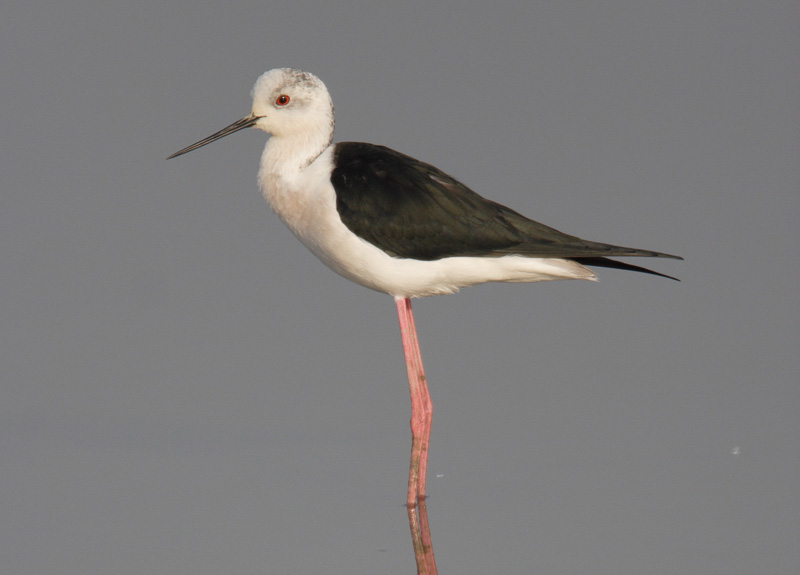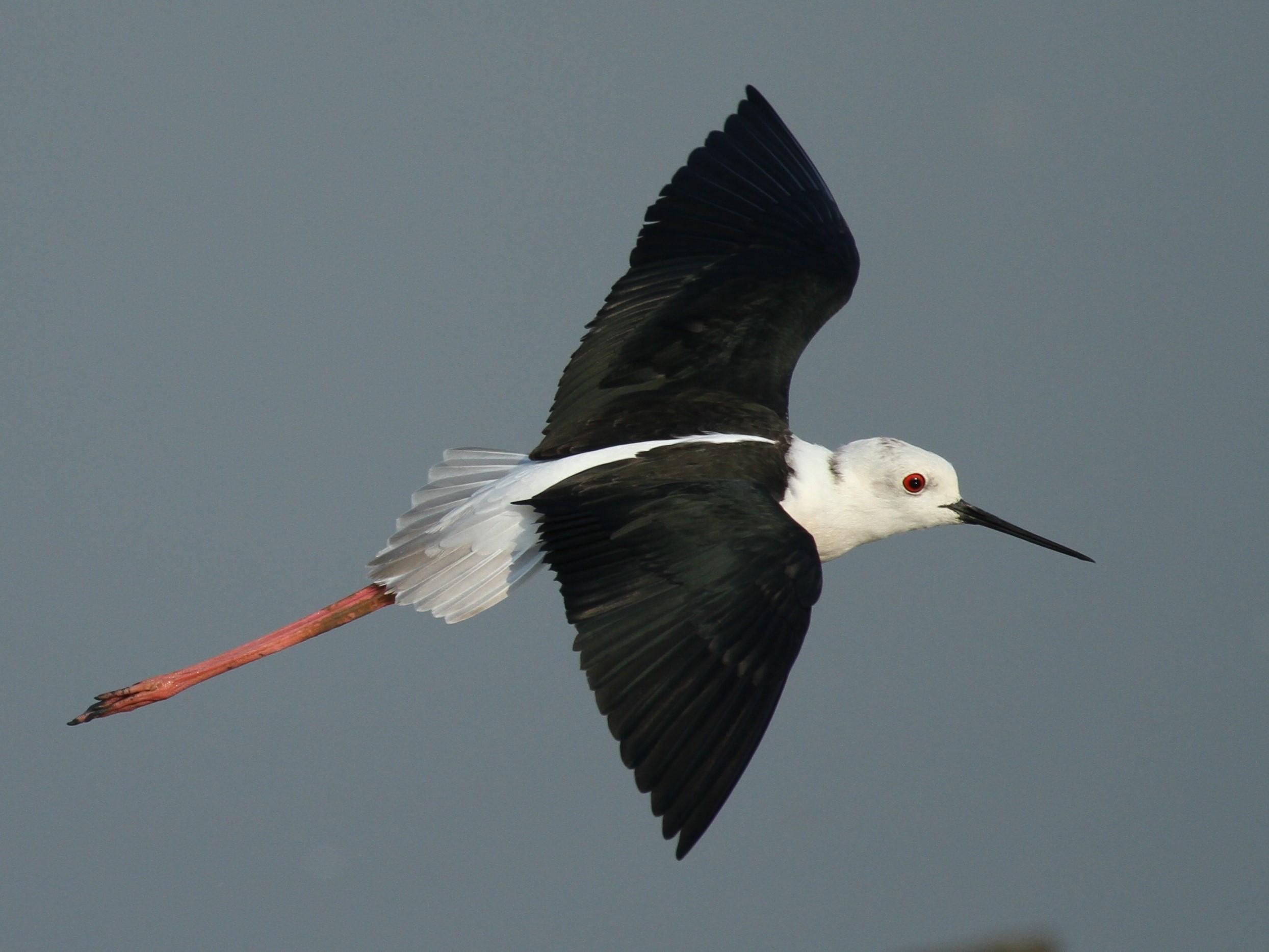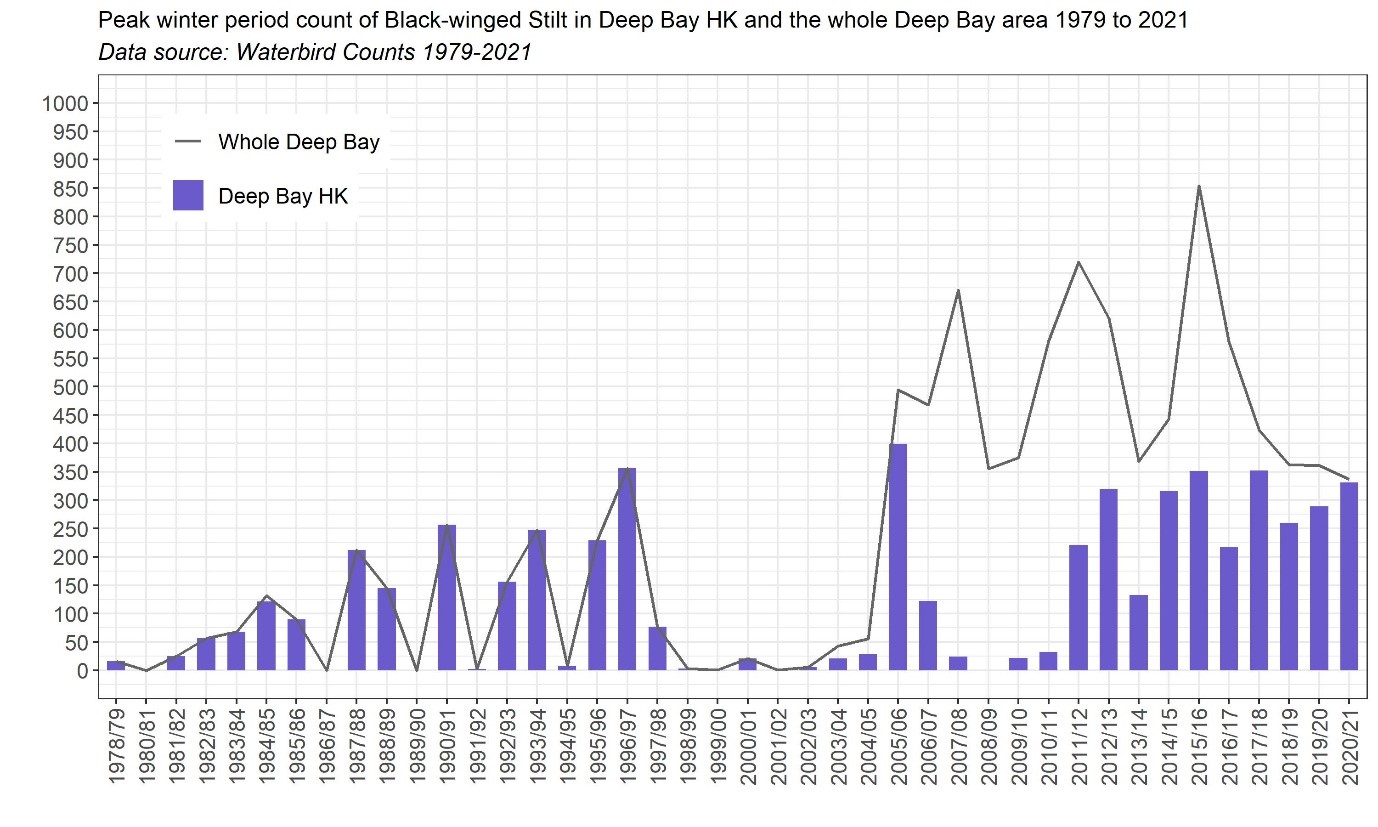Black-winged Stilt Himantopus himantopus 黑翅長腳鷸
Category I. Common to abundant in freshwater marsh, brackish gei wai and commercial fish ponds. Has increased greatly since winter 2005/06 and small numbers now breed in most years.
IDENTIFICATION

Jan. 2006, John and Jemi Holmes. Male.
33-36 cm (including bill, excluding legs). Extremely long dull orange to pink legs, medium-length fine bill and long wings make this a distinctive and elegant wader, though at times it looks rather awkward. In all plumages has a highly contrasting pattern of white underparts and dark wings (both under and upper sides) and upperparts. Head pattern is variable, with males showing blacker on average. Females have a brown tinge to mantle.

Jun. 2006, John and Jemi Holmes.
Juvenile is brown above with pale fringes to all feathers, dull legs and a whitish trailing edge to the wing in flight. First-winter birds can be identified by the retention of these features.

Jan. 2010, CHUNG Yun Tak. Male.
In flight shows long white inverted ‘V’ from leading edge of wing to the uppertail coverts and pale greyish tail. Males such as this have uniform black upperparts.
VOCALISATIONS
A very vocal species, and at some sites calls of anxious groups provide a near constant backdrop of sound.
DISTRIBUTION & HABITAT PREFERENCE
Black-winged Stilt typically occurs in freshwater marsh, brackish gei wai and commercial fish ponds in the Deep Bay area and adjacent fish pond areas of the northwest New Territories. It also occurs along the rivers draining into the bay, regularly as far inland as Kam Tin, and on the wet agricultural fields and freshwater marsh at Long Valley. Although rarely seen on the mudflats of Inner Deep Bay, the highest count there is also the highest on record in HK: 612 on 11 November 2008.
It is also recorded at widespread sites away from Deep Bay, typically in single figures and usually during the migration seasons. These include islands both large and small, the airport island at Chek Lap Kok, Discovery Bay, Kai Tak Runway Park, the Starling Inlet and Luk Keng area, Shuen Wan marsh and Pui O and other wetland areas on Lantau. The highest counts are 177 at Lam Tsuen and 75 at Cape D’Aguilar, both on 27 August 2017 during a tropical storm, with 40 at Tso Wo Hang, Sai Kung on the same date.
A breeding population has become established on shallow gei wai and ponds at Mai Po NR since 2003 with the highest count of nests being 53 in 2011; however, numbers are somewhat erratic, and in some years no birds breed.
OCCURRENCE
Based on the mean monthly total in Deep Bay waterbird counts since 1998 (Figure 1), Black-winged Stilt is a spring and autumn passage migrant, a winter visitor and a breeding species. Numbers are highest in October, while across other spring and autumn months there is broad similarity. The highest count in HK is 612 on 11 November 2008.
Although Figure 2, which plots peak waterbird monitoring programme counts, indicates that Black-winged Stilt became substantially more numerous from winter 2005-06. However, there were also high counts prior, the highest being 560 at Wo Shang Wai on 15 February 2000 and 503 at Mai Po NR on 17 October 1999.
Since winter 2005-06 the peak winter period count has been greater than 300 (prior to that, all but one waterbird count recorded fewer); the highest count for the Deep Bay area is 854 on 14 February 2016, of which 548 were present at Fu Tian. Based on winter waterbird counts in Deep Bay Sung et al. (2021) concluded that the wintering population increased from 1998 to 2017.
La Touche (1931-34) stated that Black-winged Stilt was a rare spring migrant on the China coast, though the records mentioned are confined to the east coast only as far south as Fuzhou. The first HK record was of one on 24 August 1930 (Hutson 1930). Dove and Goodhart (1955) had two records in September and April, but there were no others prior to those in HKBWS files.
BREEDING
Since 2003 Black-winged Stilts have bred at Mai Po NR in most years, with the peak nest count being 53 in 2011. They nest on recently-cleared ground and areas with little or no vegetation. Nest-building has been reported from 20 March and eggs from 11 April, while chicks have been seen from 21 April to 6 August, with four being the largest brood size noted.
BEHAVIOUR, FORAGING & DIET
As brash and loud as they are sometimes elegant, groups of Black-winged Stilts dominate fish ponds and marshes as they forage or fly when disturbed, frequently giving contact or alarm calls and taking flight in noisy parties. They are even noisier when breeding.
Mainly forages in shallow water, avoiding areas of either no or very deep water. No information on prey.
RANGE & SYSTEMATICS
Monotypic; taxonomy is debated, however.
Very widely distributed across Eurasia from the Atlantic to Pacific seaboards. Occurs in southern Europe, scattered parts of Africa (particularly the south), the Middle East, the Indian subcontinent, Central Asia, Indochina, Mongolia, China, Japan and the Philippines (Pierce and Kirwan 2020). In China it is a summer visitor to the northwest and northeast, a migrant through much of the rest of the country and winters in southern coastal areas including Hainan (Liu and Chen 2020). The HK breeding population appears rather isolated.
CONSERVATION STATUS
IUCN: Least Concern. Population trend increasing.
Figure 1.

Figure 2.

Dove, R. S. and H. J. Goodhart (1955). Field observations from the Colony of Hong Kong. Ibis 97: 311-340.
Hutson, H. P. W. (1930). Notes and comments. Ornithology. Hong Kong Naturalist 2: 80-82.
La Touche, J. D. D. (1931-34). Handbook of the birds of Eastern China Vol. 2. Taylor and Francis, London.
Liu, Y. and Y. H. Chen (eds) (2020). The CNG Field Guide to the Birds of China (in Chinese). Hunan Science and Technology Publication House, Changsha.
Pierce, R. J. and G. M. Kirwan (2020). Black-winged Stilt (Himantopus himantopus), version 1.0. In Birds of the World (S. M. Billerman, B. K. Keeney, P. G. Rodewald, and T. S. Schulenberg, Editors). Cornell Lab of Ornithology, Ithaca, NY, USA. https://doi.org/10.2173/bow.bkwsti.01
Sung, Y. H., C. C. Pang, T. C. H. Li, P. P. Y. Wong and Y. Y. Yu (2021). Ecological Correlates of 20-Year Population Trends of Wintering Waterbirds in Deep Bay, South China. Frontiers in Ecology and Evolution. Published 20 April 2021 doi: 10.3389/fevo.2021.658084

